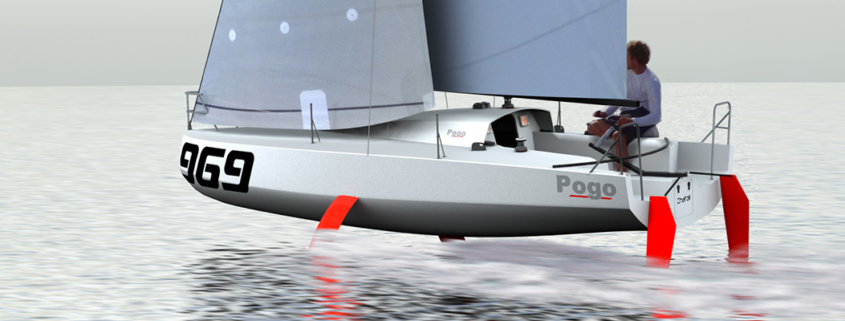Pogo Foiler: Designed By Guillaume Verdier, This little racing machine will take the Mini Transat to another level
The Pogo Foiler is a production prototype, designed to create an off-the-shelf Mini 6.50 that can compete in the experimental prototype class. François Tregouet reports
Since the Pogo 1 was launched in 1997, the Pogo Structures yard in Brittany has won ten out of the last 12 Mini Transat 6.50 races (the single-handed transatlantic race in 21-footers) in the Production class. Even more impressively, the Pogo 3 has not only won the Production fleet but also finished hot on the heels of the Prototype class many times.
This gave the French shipyard the idea of offering a ‘production prototype’, or a best of both worlds design. While it might sound paradoxical, the idea is to offer an alternative for sailors who want to go beyond the level of the production boats, without venturing into developing a complex prototype design from scratch – with a corresponding budget that’s almost impossible to control.
The initial objective was to make it simple and efficient. For simplicity, the Pogo Foiler does not have water ballast, so no pumps, piping and bulky tanks. For performance, the hull, drawn by the much-courted Guillaume Verdier, adopts the scow shape currently in vogue everywhere from the Class 40 to the IMOCA 60s. But the Pogo hull has an optimised wetted surface that is claimed to erase the ‘hole’ suffered in light air performance by some other designs.
In addition to the power aspect, the extra-wide bow also significantly reduces the volume of water getting on deck, and makes it safer to move around on the foredeck: two appreciable benefits when you’re mid-Atlantic, single-handed, aboard a boat only 6.50m (21ft 4in) long.
Flying mini
The big decision made by the design team was to make their Mini fly, which means it has specific appendages. Even though the keel is not the most complex possible, it is still both tilting and telescopic. The Mini class operates a box rule, limiting the maximum draught to 2m (6ft 7in). Prototype class Minis have for several years used rams to adjust the keel’s position when tilted. This lowers its ballast compared to a conventional pendulum keel, thus improving the boat’s righting moment.

At higher speeds, when canted to its maximum, the lifting effect of the keel is working in opposition to its ballast effect: optimum performance is, therefore, not necessarily achieved with the keel fully tilted, but slightly ‘under-keeled’. This is a subtlety that’s also been observed on the Volvo 65s and IMOCAs, and is a good illustration of the very high level of performance achieved by this little racing machine.
But what’s really unique about the Pogo Foiler is undoubtedly its foils. Whereas most IMOCA boats have been developing ‘Dali’ foils, here the architect and engineers have chosen T-shaped foils similar to those of the AC75 flying monohulls of the next America’s Cup.
The Mini rules mean that they have to fit within the maximum 3m width when retracted: so their shape, and location just forward of the point of maximum beam, are designed to make them easy to stow. The shape means they’re also more compact and better suited to the small size of the boat, providing greater surface area upwind and extending less when downwind.
Where the original intention of simplicity may have got somewhat lost is in the fact that these foils are adjustable in all three dimensions. They can obviously be moved in and out to conform to the widths imposed by the class rule (from 3m when retracted, to 5.4m max beam when both out) and limit the drag of the windward foil; but can also rake – or tilt back and forth – as well as cant up and down.
Specification
Length overall: 6.50m (21ft 4in)
Beam (foils retracted): 3.00m (9ft 10in)
Draught: 2.00m (6ft 7in)
Displacement (light): 730kg (1,609lb)
Mast height: 12m (39ft 4in)
Mainsail: 28m² (301ft²)
Jib: 21m² (226ft²)
Spinnaker: 76m² (818ft²)
Gennaker: 41m² (441ft²)
Naval architect: Guillaume Verdier
Design & build: Pogo Structures
Source: www.yachtingworld.com



